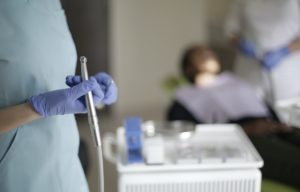After many years of repeated visits to the dentist, you may have wondered what actually happens during a dental cleaning. You might know that the dental hygienist takes care of cleaning your teeth, followed by the dentist who inspects your mouth for cavities. But do you really know what each step of your cleaning is really about? We’ll help you learn more about this topic and help you gain more knowledge on what really happens in the reclining chair, as well as help you reduce some of your anxiety for your next dental appointment.
Teeth cleanings can help prevent severe oral health issues and keep any problems from getting worse. For example, bi-yearly check-ups can lessen your risk of gum disease by removing plaque and tartar buildup, as well as preventing cavities from forming.
Initial exam
Firstly, the dental hygienist will quickly examine your teeth and gums for any signs of problem. They will check to see if your gums are healthy: these should look firm and pink. Signs of unhealthy gums include redness, swelling, bleeding and receding gums. The hygienist will also check for dark spots on your teeth for potential cavities. Before the cleaning begins, the hygienist will ask you general questions about your oral health. It’s important to report any pain or concerns of that matter.
Digital X-Rays
During the dental cleaning, you might be due for an x-ray, which should be done once a year. This quick and painless process allows the dentist to be alerted of any oral issues such as bone loss, tooth decay, tumors and cysts, gum disease and teeth movement (including wisdom teeth).
Plaque and tartar
Once the hygienist has assessed your situation, she can proceed to remove the plaque or tartar buildup that sits around your gums and between the teeth. Using a scaler, the hygienist eliminates the bacteria (plaque) that causes cavities and gum disease. If this bacteria stayed in place, it would eventually turn into tartar. Plaque can be removed yourself through brushing and flossing at least twice a day, but only a dental professional can effectively remove tartar. Remember to be gentle with your teeth at home so as to not wear down the enamel. During this step of the cleaning, you can hear scraping noises in your mouth.
Polishing
Following the plaque and tartar removal, the hygienist will remove any remaining stains on the surfaces of your teeth. They will use an electric brush with a special paste that polishes your teeth. The sound may seem uncomfortable, but it’s the best way to remove any tartar left behind from the scaler. This procedure should only be done twice a year. During this step, the hygienist might do intervals of polishing and rinsing, to help clear out the area.
Flossing
After the polishing, you might feel a gritty texture between your teeth. This is why the hygienist will finish by flossing your teeth. Nothing beats an expert flossing session! Your dental hygienist can get deep between your teeth and remove any leftover bacteria. She may also ask you about your flossing habits if she thinks your gums need improvement. Next, the hygienist will allow you to rinse your mouth to get rid of any remaining debris.
Dental exam
Finally, your cleaning will finish with an inspection by your dentist. He or she will evaluate your teeth for gum disease, check your jaw for grinding issues and examine the alignment of your teeth. They will consult your x-rays and check if you need any dental restorations (fillings, bridges, etc.). This is the time you can ask them any questions or concerns about your oral health.
Now that you know what happens during a teeth cleaning, are you ready to schedule your next appointment? Fill out the form below or call us at (450) 691-0711.
Dr. Thu Nguyen and her team will make sure you feel at ease and in good hands.
Check out our testimonials to find out more!
Schedule an appointment
[contact-form-7 id= »18559″ title= »Appointment form »]





